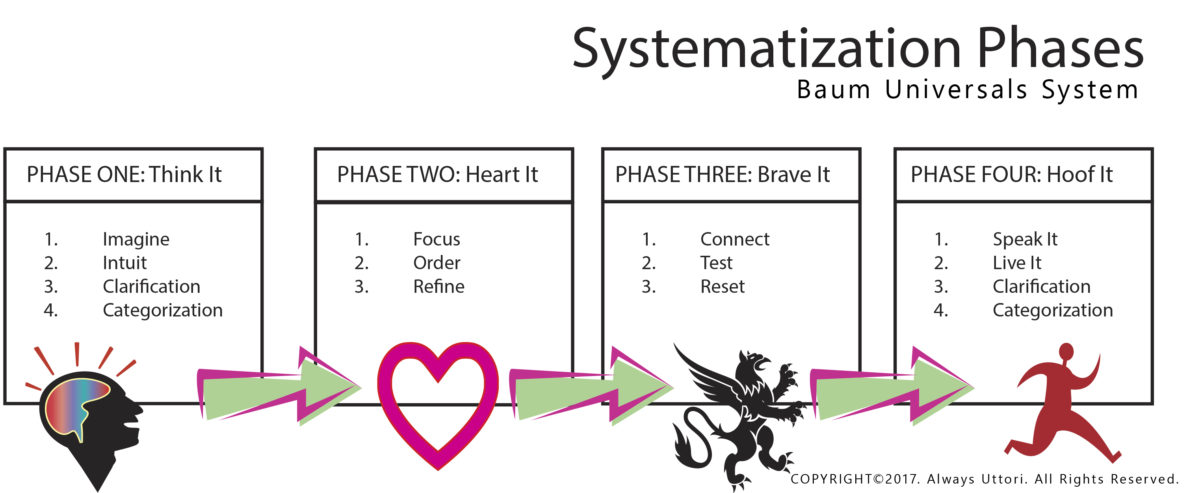Welcome back to another installment of the INTJ Mastermind Series. Today, we’re sharing tools from our Mastermind Systematization kit. If you missed the previous posts, you can check out part 1 here, part 2.0 here, and part 2.5 here. As always, I would love to know your thoughts on this, and any other blog post. It also seems appropriate to remind our beloved readers that my views are speculative in nature. I’m not a trained psychologist, nor am I certified to administer any type of personality test. However, as a former business analyst and management consultant, I have been exposed to a broad range of ideas and various systems of management theory. It is this body of expertise that I have relied on to form my theories regarding mastering the INTJ mastermind. If you feel that I’m off base in regard to the ideas presented here, please sound off in the comments. You can share love in the comments too.
One final note, when this article was originally conceived, the idea was to make it short and sweet. However, as the article has taken shape, we’ve had to make decisions regarding content. Should the article be simplified to achieve the short goal? Or, should it be based on real research, real understanding of the current perspectives that exist from disciplines such as LEAN (iterative approach), analytics, design-thinking, and cognitive psychology in regard to learning? Were this blog for anyone but INTJs, we’d have gone the short route. However, in honor of the very intelligent, analytical, and fierce readers of this blog, we’ve chosen to go the long route. This has led to some failure in getting the articles published in a timely manner. For that, we apologize. We’ve come to the decision that we will just keep on with the mastermind articles, letting the topic go where it wants to go, and exploring the research that is available to us. This, more than any other topic, has proven to be consuming, expansive, and difficult. So, Wednesday posts may be mastermind, or they may be missing, but we will, eventually, get these posts written. Again, our apologies to you all for being inconsistent. Also, this post is on the longer side, so we’ve broken it up into two parts. Again. Sigh.
The INTJ Mastermind Series Part 4: Mastering Systematization
Systematization Defined
Although we talk about systematization as a process for INTJs to master, it is actually more of a process tool. The systematization concept comes from the world of organizational management, one of a set of systems-thinking tools used in micro-organizational theory. At its core, micro-organizational theory is about how an individual’s attitudes, actions, and interactions, on a micro-level, impact the larger system as a whole. Because micro-organizational theory is focused primarily on individuals within a larger system, and systematization is a process-focused tool of micro-organizational theory, INTJs can apply systematization on an individual level for the purpose of personal mastery. In other words, big companies (the large systems) are interested in the professional development of their employees (the micro-systems), so they create processes to help employees develop their professional skills. Makes sense to me that we can use some of the concepts from micro-organizational theory to master personal life systems, taking control of our own development, as opposed to being developed by a system with the driving motive being one of profit for that system. If anything defines INTJ cognition, it is a need to not be an unthinking cog in a master system, doing what we are told, when we are told to do it. Relentless learning is one way we try to escape such a fate, but relentless learning without focus only produces arrogance and frustration. There’s no guarantee that focusing on self-directed development will free us of arrogance and frustration, but arrogance is often a sign of over-learning the inconsequential. And frustration, depending on the reason for the frustration, is often a sign of a desire to do better. Self actualization begins with the understanding that arrogance is a barrier to learning and that frustration in learning is often a result of the struggle that is part of the learning process. In this world of INTJ mastermind development, those are the definitions that we use for the two terms.
Note: I try to break this language down into human speech, but sometimes, when I’ve done a lot of research, I start writing like a research drone. My apologies if any of this seems overly technical.
In the previous mastermind article, we outlined some of the benefits of systematization in relation to INTJ mastermind mastery.
10 Key Benefits of Systematization
- Manage complexity
- Define connections between experience and learning
- Validate the activities associated with mastery processes
- Identify roadblocks and challenges
- Identify cognitive biases that hinder understanding and growth
- Helps INTJs manage decision fatigue by systematizing decision and analysis processes
- Helps INTJs utilize intuition as a tool to conceive and initiate abstract ideas
- Helps INTJs use multiple modes of thinking: intuitive mode, affective mode, analytics mode, reflective mode, and sequencing mode
- Helps INTJs develop system models to use as heuristics for faster decision-making
- Helps INTJs rapidly integrate new learning
Clearly, there are many benefits to using systematization as a tool in masterminding. Yet, before you can whip systematization out of your INTJ Mastermind Tool kit, you need one very important thing — a system to systematize.
The INTJ Master System
L. Frank Baum, author of The Wonderful Wizard of OZ, must have been a brilliant systems thinker because there, front and center in his heartwarming story of a girl who just wants to return home to her aunt and uncle in Kansas, is a universal system. Baum’s universal system (BUS, if they’d used one, they could have gotten to the Emerald City much faster) has nothing to do with Dorothy’s story goal of returning home. It has nothing to do with flying monkeys, nor the identity of the wizard. Instead, Dorothy, along with her companions: the Tin Woodman, the Cowardly Lion, and the brainless Scarecrow, each represent a life system that must be mastered for Dorothy, the primary system, to realize her goal of getting back to Kansas. Most of us know what each character is supposed to represent. For example, the Tin Woodman represents the heart (feeling). The Scarecrow is cognition or (thinking). The Cowardly Lion is courage (or, to relate to MBTI, sensing). The Wizard, intuition, takes all of these disparate problems and identifies a solution for each character, or aspect, of the system. I don’t know if Baum intentionally created this system; nor do I know his MBTI, though if the following quote attributed to him: “Hearts will never be practical until they can be made unbreakable” is any indication, he may have been an INFJ (many writers are).
A Mastermind’s First System
So what does Baum’s system have to do with mastering systematization? Well, I think it’s relevant because it doesn’t matter who you are, nor does your cognition style matter, if you want to be a mastermind, mastering your thinking, your feeling, your sensing, and your intuition, mastering all of the universals of your system is important. I don’t mean running around like some kind of intense, goals focused maniac. I mean that prioritizing these systems equally is essential to mastering the mastermind. Balance is key. Interestingly, the four universal systems relate to what we, as a society, have determined to be the hallmarks of a well-lived life: career, relationships, health, and soul (mind, heart, body, aesthetic). Unfortunately, despite being known for our intelligence, many INTJs only focus on the mind. Yet, a true mastermind masters all of the systems in her life — not just the fun ones, not just the easy ones.
So, now that we’ve got our first system to mastermind, it’s time examine systematization tools.
Master Systematization Visually
The Power of Visual
When we talked about thinking, the focus was on an activity that could seem intangible; and yet, focused thinking can also yield powerful results. Systematization is different. Systems are made up of multiple interconnected parts intended to function as a single unit. Each of these systems must operate effectively for the whole to be effective. Masterminds use visual tools to model systems because different parts of a system can have different levels of complexity, and/or attributes. The late Seymour Papert, an MIT professor and pioneer of artificial intelligence, felt so strongly about the importance of using visual tools, that he developed a learning theory, inspired by the work of Jean Piaget, called constructivism. Constructivism relies on visual tools to integrate new knowledge with old knowledge. In recent years, there has been an explosion of interest in using visual tools as a basis for problem solving, organizational design, and even business development. This interest is not simply a result of fashion, neuroscience has identified strong correlations between our vision, and our ability to make decisions. How is this possible? According to Dan Roam, in his groundbreaking book, The Back of the Napkin, 90% of the visual signals that our brains receive, get processed by the neocortex, which is the top layer crossing the cerebral (left and right) hemispheres, and the part of our brain responsible for high-level processing. The brain is so adept at processing visual images, that it can process an image in as little as 13 milliseconds. This rapid-fire processing of images indicates that vision processes for conceptual information. It stands to reason that, by using the brain’s conventional method of information processing, INTJ masterminds have the potential to obtain better outcomes in terms of identifying, refining, and achieving goals.
There is no doubt that visual equals powerful. Ultimately, visual tools allow us to step back, to analyze information from multiple perspectives, and to tailor our systematization approach. Visual simplifies universal systems. When the key defining characteristic of systemic thinking is that systems must be viewed as part of a whole, and as a whole of parts, simplification is important.
B.U.S. the Process
” You are learning something every day. A baby has brains, but it doesn’t know much. Experience is the only thing that brings knowledge, and the longer you are on earth the more experience you are sure to get.”
~The Wizard, The Wonderful Wizard of Oz
In the above quote, Oz tries to get the scarecrow to forego his goal of getting brains by telling him that experience is the only thing needed. While that may have been true at the time Baum was writing, over the past twenty years, the growth in data and information has made the need for experience far less important than it once was. We are living in what some call, “the digital age,” and others call, “the analytics age.” Whatever the age in which we live, many of the realities of modern-day life are the result of intuition-driven conception and back-of-the-napkin mapping. In fact, experience can, on occasion, hamper progress. The cool thing for us is that the universals Baum embedded in his story center on personal growth. When using these tools, put doubt aside. Tamp down worry about your level of experience. When the goal is personal growth, you dream big. You live large. You master your mind like it’s a palace. Dream big enough to get out of Kansas . . . How? Follow the yellow brick road . . . Ready? We’re off to see the wizard. . . Now that I’ve got all the stupid puns out of my system, let’s take a look at visually mapping your universals (or, what I like to call, systematizing your system) if we take L. Frank Baum’s lovely story and re-imagine it as a set of systematization process tools in an INTJ personal mastery system.

Most of us know that, in story terminology, what happens in a story is called the plot. Plot is a pretty simple concept. One thing happens and then another, and then another. Pretty soon, you’ve got a story – only, not every story is a page-turner. Many stories are pretty boring. One of the tools that writers use to capture a reader’s interest is to give their character motivation enough to act. For masterminds, strategizing our personal life journeys (we don’t just do things, we plan them), gives us motivation to act. Connecting motivation with action amps up our ability to master systematization, because we’re not just “goal digging,” we’re acting based on motivation.
Universals Phases
“… So I believe that dreams – day dreams, you know, with your eyes wide open and your brain-machinery whizzing – are likely to lead to the betterment of the world. L. Frank Baum, The Lost Princess of Oz
Mastering systematization is about systematizing a success model. Success model for what? For your universals. For your mind, body, heart, or soul goals. If you’ve been exposed to any type of systems thinking, most of these phases will be very familiar, and these posts may just be refreshers . The real difference for this system is that it connects elements of the INTJ cognition style to a system, allowing those of us who use INTJ cognition to understand which aspects of our cognition style can best serve as an aid during the different phases of our personal development journey.
Think It and Think Again
“So the Wizard unfastened his head and emptied out the straw. Then he entered the back room and took up a measure of bran, which he mixed with a great many pins and needles. Having shaken them together thoroughly, he filled the top of the Scarecrow’s head with the mixture and stuffed the rest of the space with straw, to hold it in place. When he had fastened the scarecrow’s head on his body again he said to him, “Hereafter you will be a great man, for I have given you a lot of bran-new brains.” Chapter Sixteen, The Wonderful Wizard of Oz
In the past, we’ve talked about how INTJ’s access intuition as their possibilities engine. As this is one of the INTJ’s dominant cognitive function, it is unlikely that it will be underdeveloped; however, you may have learned not to trust your intuition because intuition can seem so insubstantial. Yet, far from insubstantial, your intuition is constantly at work gathering data and processing that data to help you make decisions. The human brain is made up of 100 billion neurons, with unmeasured memory capacity. The more data your intuition can access, the more accurate your intuition, and the closer you will be to your motivation to act. In phase one, you will use your intuition to identify the universals that are relevant to your personal journey. Phase One is about going from abstract to refined, unplanned to planned, and from disorder to systematization.
Essentially, Think It is that first step in identifying goals for each aspect of your universals. It’s important to keep in mind that throughout each of these phases, you will be using your intuition in different ways. In the Think It phase, you will use your intuition to conceive of possibilities for each of your universals. Conception is only one element of systematization. Along with clarification, and categorization, defining a logical frame of reference is just as important as the act of thinking. Much like the scarecrow in Oz story, we sometimes need to refresh the materials we use for our thinking. Modeling our universals is one way to get out of our heads, and to see in black and white, or living color, what we are thinking. Modeling our intuition takes us beneath the surface of our personal stories. Think It shifts our stories from “slice of life” to “quest, or adventure” stories. Yes, I know that there are mixed metaphors all over the place in this post.
Heart It
“So Oz brought a pair of tinsmith’s shears and cut a small, square hole in the left side of the Tin Woodman’s breast. Then, going to a chest of drawers, he took out a pretty heart, made entirely of silk and stuffed with sawdust.” The Wonderful Wizard of Oz
Phase Two: Heart It is focused on truly refining your universals. I don’t know if life is about choices, or experiences, or just putting one foot in front of the other and being the most successful person you can be. I do know that in the midst of all this “purpose-driven” life kind of talk with which we are constantly bombarded, there are experiences, and ways of being that draw us. Those things that draw us, the activities, the choices, the experiences, are reflections of our most authentic selves. Maybe it sounds a bit too much like Oprah’s “best life” slogan, but INTJs need to feel that they are living authentically. The Heart It phase is about living authentically.
The Tin Woodman wanted a heart that he described as kind. He wanted to feel the emotion of love (at least in the movie version). There is no doubt that love is a powerful and moving force for some, but INTJs value logic and reason above a life focused on the emotion. For us, focusing so much effort on the experience of love seems very limiting. Instead, we want to prefer to connect logic to action, but when we can connect logic AND emotion, we are completely committed. The BUS starts with logic. Heart It isn’t really as much about emotion, as it is about necessity. When you move a universal from something identified by your intuition to the Heart It phase, you are drawing a line in the sand. You are saying to your psyche that this thing is authentic. This is important. I’ve considered it. I’ve reasoned it out. INTJ females don’t throw around their emotions, or their love, lightly. As any INTJ female will tell you, If I love you. I love you. For INTJ females, love is so profound, we do not open that door until we can trust you. Think It allows you to consider your decision so that you can trust your intuition. The Heart It phase allows you to move forward with genuine commitment.
Brave It
“He went to a cupboard and reaching up to a high shelf took down a square green bottle, the contents of which he poured into a green-gold dish, beautifully carved. Placing this before the Cowardly Lion, who sniffed at it as if he did not like it, the Wizard said: ‘Drink.'” ~The Wonderful Wizard of Oz
Ah, just do it phase, that’s Brave It. Brave It gets exciting as you take your universals from conception to reality. Yet, just like the cowardly lion, INTJs can be very cautious in taking action. Part of the reason for what may appear to be over-caution to some, is the INTJ ability to logic out the consequences of our choices. We can step through failure consequences to the 10th degree. We can see the pitfalls and traps. Worst of all, we can see, all to well, the potential for failure. INTJs do not like to broadcast our failures. We prefer to practice skills development in dark, solitary space, thousands of miles away from the curious. The Brave It phase is testing our commitments from phase two. It doesn’t matter if things aren’t perfect. Braving is more about testing your choices to determine if they really are authentic to the life you want. Are you becoming who you wish to be. Braving It is also a data-gathering phase. It’s about seeing, in real-time, whether you succeed or fail. If you succeed, you focus on getting better. If you fail, you go back to the drawing board and make different decisions based on the data, because both failure and success are nothing more than data points. To make them anything more is to become defined and limited by them.
Hoof It
“The Silver Shoes,” said the Good Witch, “have wonderful powers. And one of the most curious things about them is that they can carry you to any place in the world in three steps, and each step will be made in the wink of an eye. All you have to do is to knock the heels together three times and command the shoes to carry you wherever you wish to go.” The Wonderful Wizard of Oz
One of the things I love about the quote above is that he has given us a book of key universals, of life systems. And in the quote above, he gives measures. Baum lived in the era of mechanization and industrialization. It was truly an era of systematization. Systems require measurement. That’s what the above quote gives us. 3 steps to success. The 3 steps will be made in “the wink of an eye.” To get the process started, knock your heels together 3 times. The Good Witch has given Dorothy a model for repeatable success. That is, in essence, what the Hoof It phase is about – learning how to repeat your successes.
There you have it. A brief overview of the systematization tools for the INTJ mastermind based on L. Frank Baum’s story, The Wonderful Wizard of Oz. In my mind, Baum was brilliant. Really. Yet, he failed over and over in his life, even after the publication of Oz series. Baum, despite some very public failures, took the lessons he learned, and chased his dreams. He lived his life authentically. For those of us who are INTJs, mastering the universals of Mind, Heart, Body, and Soul can ensure that we don’t fall into the trap of over-learning the inconsequential, but that we are focused on becoming individuals who are wholly developed, who are authentic, and who truly understand what it means to be masterminds.
Check out part 5 of the Mastermind Series here!






Really interesting read. I think my biggest stumbling block is the Love It phase — I kind of by default disregard any kind of emotional response in decision making to a point where I’m not even aware if I find something genuine/authentic; it naturally is or isn’t based on if it makes sense logically.
So I guess in a way I am doing the Love It phase but in a very INTJ kind of way — all that emotional response is filtered out in order for something to feel authentic, because authenticity cannot exist if something doesn’t make rational sense to me. Wow does that make any kind of sense? Describing how my mind works is actually quite difficult.
I need a cookie.